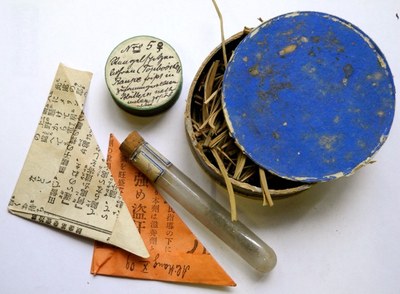M.A. Kerstin Pannhorst
- Name
- M.A. Kerstin Pannhorst
- kerstin.pannhorst (at) hu-berlin.de
Vita
Kerstin Pannhorst graduated from the University of Freiburg in historical anthropology, German linguistics and biology. She also spent a year at the Université de Montréal studying linguistic anthropology. After graduating, she worked as a research assistant in biological anthropology at the University of Freiburg, where she was responsible for planning a section of the cultural history exhibition Schiller’s Skull – Physiognomy of an Idée Fixe for the Schiller-Museum in Weimar. In the 2009/2010 academic year, she attended the International Chinese Language Program at National Taiwan University on a DAAD-fellowship. 2010 to 2012 she worked on several cultural history exhibitions as a research assistant at the Neanderthal Museum in Mettmann near Düsseldorf, most notably the anniversary exhibition Looking at Apes. 2013 to 2015 she was a research assistant at the department PAN – Perspectives on Nature of the Museum für Naturkunde Berlin. As a member of the research project Wissensdinge (Objects of Knowledge) funded by the BMBF, she co-edited a book of the same name. She spent the 2016/2017 academic year at the Institute of Taiwan History at Academia Sinica in Taipei as a predoctoral fellow. Since 2016, she is a doctoral student at the Chair for the History of Science at Humboldt-University in Berlin and since September 2017 also at the Max Planck Institute for the History of Science.
Research interest
- History of 19th and 20th century science
- History of the life sciences
- History of natural history collecting
- Networks of knowledge between East Asian and Europe
Current project
Insects as a Global Commodity: Collecting Specimens in early 20th century Taiwan
The project takes a closer look at the practices of collecting, processing, and trading insects in early 20th century Taiwan, specifically the entanglement of practices surrounding research specimens and specimens collected for the decorative arts. In the „field“, in this case the mid-altitude mountains of central Taiwan, diverse actors competed for specimens: Some desired insects for taxonomical and biogeographical descriptions, others for research into economically relevant species, and yet others for the production of decorative objects. The dissertation explores whether scientific and artisanal practices stabilized each other, leading to a mass production of insect artifacts and insect knowledge.
 Early in the 20th century, Hans Sauter, a German entomologist and collecting entrepreneur based in Taiwan, collaborated with the first director of the German Entomological Museum in Dahlem towards the „mass-fabrication of knowledge“ about Taiwan's insect world. Tens of thousands of carefully packaged insects collected in the Japanese colony Taiwan were sent along global trading routes towards the goal of a successive publication of a „complete fauna of Formosa“. In the same period, Yasushi Nawa, a Japanese entomologist and entrepreneur, sent scores of insect collectors to the island. The animals served both for research into injurious and beneficial species and for the production of decorative objects such as paper fans or postcards made using butterfly specimens. He sold butterfly decorative art via mail order and in department stores in Japan and abroad. Fleas, beetles or butterflies became resources that were accumulated, traded, and turned into artifacts – into „authentic“ representations of nature for research purposes or into aesthetic commodities. The project follows the insects from the field to the natural history museum respectively the department store. It focuses on the entanglement of the highly specialized practices involved and on the economies behind the global circulation of these fragile materials.
Early in the 20th century, Hans Sauter, a German entomologist and collecting entrepreneur based in Taiwan, collaborated with the first director of the German Entomological Museum in Dahlem towards the „mass-fabrication of knowledge“ about Taiwan's insect world. Tens of thousands of carefully packaged insects collected in the Japanese colony Taiwan were sent along global trading routes towards the goal of a successive publication of a „complete fauna of Formosa“. In the same period, Yasushi Nawa, a Japanese entomologist and entrepreneur, sent scores of insect collectors to the island. The animals served both for research into injurious and beneficial species and for the production of decorative objects such as paper fans or postcards made using butterfly specimens. He sold butterfly decorative art via mail order and in department stores in Japan and abroad. Fleas, beetles or butterflies became resources that were accumulated, traded, and turned into artifacts – into „authentic“ representations of nature for research purposes or into aesthetic commodities. The project follows the insects from the field to the natural history museum respectively the department store. It focuses on the entanglement of the highly specialized practices involved and on the economies behind the global circulation of these fragile materials.
Picture credits: Packaging materials used by Hans Sauter to send Lepidoptera from Taiwan to Germany in the early 20th century. Museum für Naturkunde Berlin, coll. Lepidoptera and Trichoptera. Photo by Kerstin Pannhorst.
Publications
As editor
Hermannstädter A., Heumann I., Pannhorst K. (Hg.): Wissensdinge. Geschichten aus dem Naturkundemuseum. Nicolai Verlag 2015.
Auffermann B, Pannhorst K. (Hg.): Wie Menschen Affen Sehen. Stiftung Neanderthal Museum 2012.
Articles
Pannhorst K.: "Zirkulieren. Hans Sauter und der Wert von Insekten". In: Heumann I., Güttler N. (Hg.): Sammlungsökonomien, Kulturverlag Kadmos 2016, S. 71-93.
Pannhorst K.: "Verpacken, Verkaufen, Verschenken: Entomologische Praktiken zwischen Formosa und Berlin 1902-1914". In: Berichte zur Wissenschaftsgeschichte 39/3 2016, S. 230-244.
Hermannstädter A., Heumann I., Pannhorst K.: Fisch und Wissensding. "Zur Bedeutung naturkundlicher Objekte". In: Hermannstädter A., Heumann I., Pannhorst K. (Hg.): Wissensdinge. Geschichten aus dem Naturkundemuseum, Nicolai 2015, S. 10-25.
Pannhorst, K.: "Das Phänomen Panda". In: Damaschun, Ferdinand: Panda. Das Buch zur Sonderausstellung im Museum für Naturkunde, Berlin 2015, S. 6-9.
Pannhorst, K.: "Von wem stammt der Affe ab?" In: Auffermann B, Pannhorst K (Hg.): Wie Menschen Affen Sehen. Stiftung Neanderthal Museum 2012, S. 10-19.
